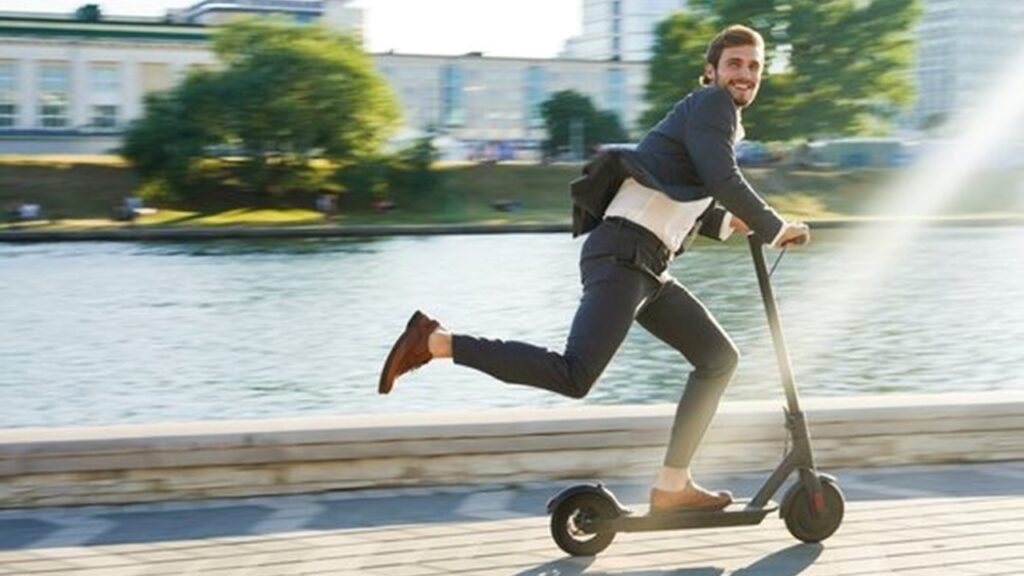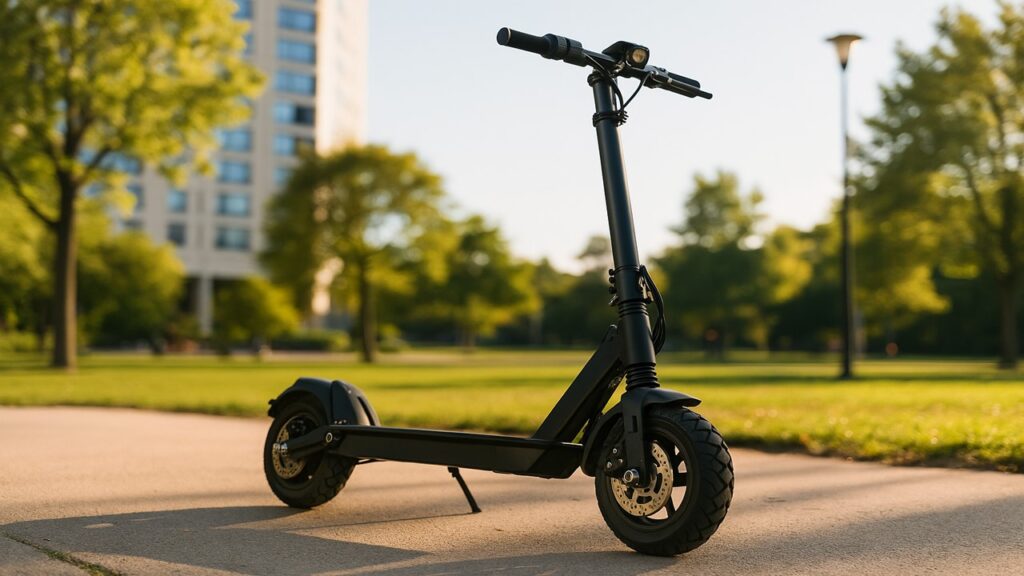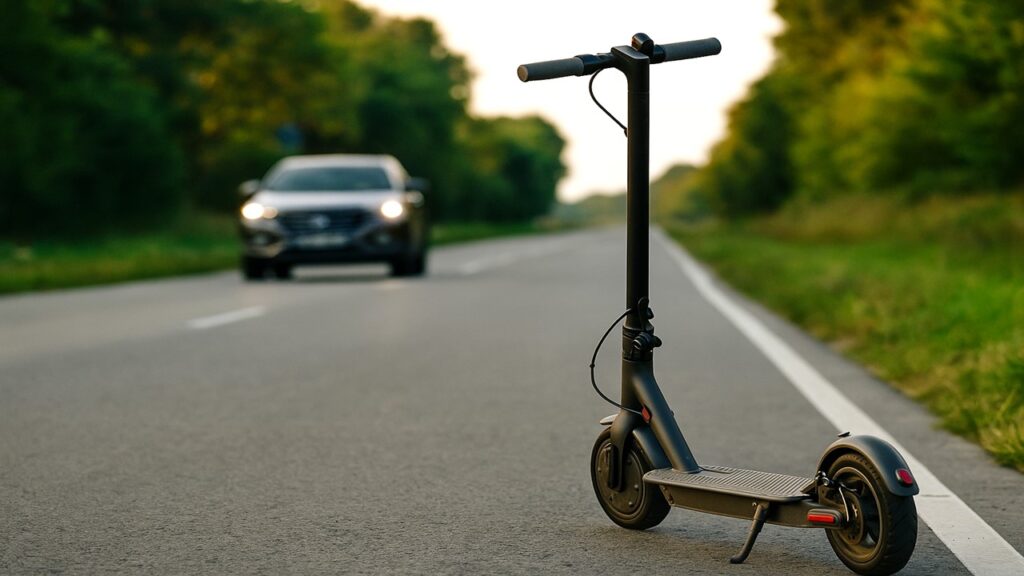
In most U.S. cities, it is not legal to ride an electric scooter on the sidewalk. Sidewalks are designed for pedestrians, and most local and state laws require e-scooter riders to use bike lanes, shared-use paths, or low-speed streets instead.
Key Summary:
- Riding an electric scooter on the sidewalk is illegal in most U.S. cities, though a few states like Colorado and Washington allow it under strict low-speed limits and pedestrian-yield rules.
- Local and state governments set specific scooter regulations, and violations can lead to fines ranging from $25 to $500, depending on the jurisdiction.
- Sidewalk restrictions exist primarily to protect pedestrians and maintain safety, as sidewalks are designed for walking speeds, not motorized travel.
- The safest and most legal alternatives to sidewalk riding are bike lanes, shared-use paths, or low-speed residential roads, where scooters and bicycles share similar rights and responsibilities.
In most U.S. cities, it is not legal to ride an electric scooter on the sidewalk. Sidewalks are designed for pedestrians, and most local and state laws require e-scooter riders to use bike lanes, shared-use paths, or low-speed streets instead.
Electric Scooter Sidewalk Laws at a Glance
Across the United States, electric scooter laws vary depending on where you live. While there are no federal rules that govern sidewalk riding, most state and city laws prohibit it to protect pedestrians. Cities such as Los Angeles, New York, and Chicago have strict bans, whereas places like Colorado or Washington allow sidewalk use only under low-speed conditions—usually around six miles per hour.
If you’re unsure about the rules in your area, always check your local Department of Transportation website or city ordinances before riding. Violations can result in fines ranging from $25 to $500, depending on the location. For the safest and most compliant ride, stick to designated bike lanes or low-traffic streets and always yield to pedestrians when passing.
Understanding Why Sidewalk Riding Is Often Illegal
Many cities restrict or ban sidewalk riding for one key reason—pedestrian safety. Sidewalks are meant for foot traffic, and the speed and quiet operation of electric scooters can create hazardous situations.
Key reasons cities ban sidewalk riding:
- Pedestrian protection: Collisions between scooters and walkers can cause serious injuries.
- Infrastructure design: Sidewalks aren’t built for wheels—they’re uneven and narrow, increasing accident risk.
- Accessibility concerns: Scooters can block access ramps, crosswalks, or paths for people with disabilities.
- Legal liability: Municipalities aim to reduce injury claims from mixed pedestrian-scooter use.
Pedestrian Safety Concerns
Electric scooters travel much faster than walking speed, making sidewalks unsafe for pedestrians. A sudden turn or distraction can lead to collisions, especially in crowded areas. Children, the elderly, and people using mobility aids are particularly at risk, prompting most cities to enforce strict sidewalk bans.
Infrastructure and Design Limitations
Sidewalks are uneven and often cluttered with signs, curbs, and driveways. These obstacles make it difficult for riders to control scooters safely. Even small bumps can lead to accidents or falls, which is why roads and bike lanes—built with smoother surfaces and clearer visibility—are the preferred alternatives.
Community and Legal Responsibility
City planners and local governments design transportation systems to minimize risk for everyone. Allowing high-speed scooters on sidewalks increases liability and undermines public trust. Keeping scooters in bike lanes or on low-speed streets ensures predictable, safer movement for all users.
Electric Scooter Sidewalk Laws by Government Level
There isn’t one universal law across the U.S.; rules differ by federal, state, and local authority. Each level sets its own guidelines for where and how scooters can be ridden.
Key takeaways:
- Federal agencies focus on safety standards, not enforcement.
- State laws define where scooters may operate.
- Local governments decide sidewalk rules and speed limits.
Federal Guidelines (CPSC and ADA)
The Consumer Product Safety Commission (CPSC) regulates electric scooter manufacturing and safety, but it doesn’t dictate where you can ride. Federal law doesn’t prohibit sidewalk use; that authority is left to states and cities. However, scooters used as mobility aids fall under the Americans with Disabilities Act (ADA), which protects the right to use mobility devices on sidewalks and in public areas.
State-Level Rules and Examples
States handle e-scooter classification and define where riding is allowed:
- California: Prohibits sidewalk use statewide (CVC §21235). Riders must use bike lanes or the right-hand side of the road.
- Colorado: Allows sidewalk riding if there’s no bike lane, provided speed stays under 6 mph.
- Washington: Permits scooters on sidewalks under 6 mph and with pedestrian right-of-way.
- Florida: Leaves the decision to local governments; some cities ban it, others allow in residential zones.
- New York: Bans scooters on sidewalks entirely, especially in New York City.
Local Ordinances and City Variations
Cities often layer additional restrictions. Los Angeles and San Francisco prohibit sidewalk use altogether, while Austin, Texas allows it in quieter residential areas. Enforcement and penalties vary: some cities issue tickets, others impound scooters left in pedestrian zones. Always check posted signs, as city blocks can have differing rules even within the same municipality.
Can You Ride an Electric Scooter on the Sidewalk?
The short answer: usually no, unless local laws explicitly permit it. In most major cities, scooters are treated as vehicles rather than pedestrian devices, meaning they must share roads or bike lanes with cyclists and follow standard traffic laws.
That said, a few areas—mainly smaller towns or suburban neighborhoods—do allow sidewalk riding at low speeds. In these cases, riders must yield to pedestrians, stay under 6 mph, and keep a safe distance. Even when technically legal, it’s safer and more considerate to use bike lanes or shared paths whenever available. Riding responsibly not only avoids fines but helps build public trust in micro-mobility options like e-scooters.
Exceptions and ADA Mobility Rights
While most electric scooters are banned from sidewalks, there are exceptions for individuals using them as mobility aids. Under the Americans with Disabilities Act (ADA), electric or motorized scooters used by people with mobility impairments are legally recognized as assistive devices. This distinction allows them to operate in areas—such as sidewalks, stores, and public facilities—where standard scooters are restricted.
ADA protection ensures accessibility and independence for those who rely on mobility devices for daily movement. Cities and businesses must accommodate these users by allowing access to sidewalks, elevators, and ramps. However, this protection applies only when the device is genuinely used for mobility, not for recreational or commuter purposes.
ADA protections for riders using scooters as mobility aids:
- Users have the right to ride on sidewalks, inside public buildings, and transportation hubs.
- Businesses and municipalities cannot deny access to individuals using scooters as mobility devices.
- Mobility scooters are covered under ADA Title II (public entities) and Title III (public accommodations).
- Riders are encouraged to identify their scooters as mobility aids if questioned by law enforcement or property staff.
- The ADA does not cover recreational or rental scooters, even if used by individuals without documented disabilities.
Fines, Penalties and Enforcement
Violating local e-scooter sidewalk laws can lead to monetary fines, scooter impoundment, or suspension of rental accounts. The amount and enforcement method vary depending on city and state regulations.
| City/State | Violation | Fine Range | Authority / Enforcement |
| California | Riding on sidewalk | Up to $250 | California Highway Patrol |
| Denver, CO | Riding in restricted sidewalk zones | $100 | Denver Department of Transportation |
| Austin, TX | Parking or blocking sidewalks | $75–$100 | Austin Transportation Department |
| New York City | Riding or parking on sidewalks | $100–$200 | NYPD / NYC DOT |
| San Francisco | Unlawful sidewalk use or obstruction | $135 | SFMTA Enforcement |
Safe and Legal Alternatives to Sidewalk Riding
When sidewalks are off-limits, several safer and more compliant routes exist for scooter riders.
Best legal alternatives include:
- Bike lanes and protected cycling paths
- Shared-use or multi-modal trails
- Residential roads with speed limits under 25 mph
- Designated micro-mobility corridors in some cities
Each of these options prioritizes safety while maintaining efficiency for short-distance travel.
Bike Lanes
Bike lanes are the most suitable and widely accepted areas for scooter travel. They provide dedicated space separate from cars and pedestrians, minimizing collision risks. Many states classify scooters similarly to bicycles, granting them equal rights in these lanes. Riders should stay to the right, maintain predictable movement, and use hand signals when turning or stopping.
Shared Multi-Use Paths
Shared paths are open to both pedestrians and small vehicles such as bicycles and scooters. They are often found near parks, campuses, or waterfronts. While scooters are allowed here, riders should keep speeds low and yield to pedestrians. Maintaining awareness and using a bell or light signal helps prevent conflicts on these shared surfaces.
Low-Speed Residential Streets
If bike lanes or shared paths aren’t available, scooters can operate on roads with speed limits of 25 mph or lower. These streets typically have less traffic and wider shoulders, making them safer for small personal vehicles. Riders should wear helmets, obey traffic lights, and stay visible using lights or reflective gear, especially at night.
If You Must Use the Sidewalk
In rare cases, sidewalk use may be unavoidable—such as in construction zones, areas without bike lanes, or narrow streets with heavy traffic. When that happens, riders should proceed cautiously and follow etiquette that prioritizes pedestrian safety.
Essential guidelines for limited sidewalk riding:
- Ride at a walking pace (5–6 mph maximum).
- Always yield to pedestrians.
- Announce your approach or use a bell when passing.
- Keep a safe distance from building entrances and crosswalks.
- Dismount and walk the scooter in crowded areas.
Safe Riding Etiquette
When riding on sidewalks, slow speed and awareness are critical. Avoid sudden turns or abrupt braking, as these actions can startle pedestrians. Make eye contact with those around you before passing and maintain at least three feet of clearance whenever possible. Riders should avoid distractions such as headphones or phone use while navigating pedestrian areas.
Parking and Courtesy
Improper scooter parking is one of the top complaints from pedestrians and city officials. Always park your scooter upright in designated parking areas or near curb edges without blocking ramps, doors, or pathways. In cities with rental programs, users may be required to submit a photo of their parked scooter to confirm compliance. Responsible parking reduces clutter and keeps walkways accessible for everyone.
Common Myths vs Facts About Scooter Sidewalk Laws
There are widespread misconceptions about where scooters can legally be ridden. Understanding these differences helps prevent fines and ensures safer streets for all.
| Myth | Fact |
| Riding on the sidewalk is safer for scooter users. | Sidewalks are for pedestrians; uneven terrain and collisions make them more dangerous for scooters. |
| Scooters are exempt from traffic laws. | Electric scooters are legally classified as vehicles in most states and must follow bike and traffic rules. |
| Kids can ride scooters anywhere. | Many states enforce a minimum age requirement, often 14–16 years old. |
| Only rental scooters are restricted. | Personal and rental scooters are both subject to the same local and state regulations. |
| Sidewalk bans apply everywhere. | Some smaller towns and residential zones allow limited sidewalk use at low speeds. |
Expert Insights and Safety Recommendations
Transportation safety experts emphasize that electric scooters should be treated as vehicles, not pedestrian devices. According to the U.S. Consumer Product Safety Commission, most scooter-related injuries occur when riders fail to follow traffic laws or ride on sidewalks not designed for motorized vehicles. Safety officials recommend that all riders wear helmets, use proper lighting at night, and maintain moderate speeds even in legal areas to reduce risk.
Urban mobility planners also highlight the importance of proper lane discipline and predictability. Riders who use bike lanes or low-speed roads instead of sidewalks not only stay safer but also help cities integrate scooters more effectively into traffic systems. Following local regulations, signaling turns, and respecting pedestrian zones contribute to a smoother, safer coexistence between riders, cyclists, and walkers.
Community Impact and Accessibility
Electric scooters can improve city mobility by offering low-emission, short-distance transportation. However, improper sidewalk use can negatively impact communities, especially pedestrians, seniors, and people with disabilities. Scooters parked haphazardly or ridden at high speeds on walkways often obstruct wheelchair ramps, doorways, and public pathways—reducing accessibility for those who rely on safe, unobstructed sidewalks.
Cities that enforce clear scooter policies tend to see better integration and public acceptance. Designated parking zones, protected bike lanes, and public education campaigns make it easier for everyone to share urban spaces responsibly. Responsible riding ensures scooters remain an eco-friendly benefit to city infrastructure rather than a safety concern or accessibility challenge.
Safe Riding Checklist
Every scooter trip should follow a few essential safety habits to keep riders and pedestrians protected.
Quick safety reminders:
- Check local scooter laws before riding.
- Use bike lanes or shared paths when available.
- Keep speed under control—especially near pedestrians.
- Always wear a helmet and visible clothing.
- Use lights and reflectors at night.
- Park in designated areas without blocking sidewalks.
Final Words
Riding an electric scooter on the sidewalk is illegal in most areas because it poses risks to pedestrians and disrupts accessibility. Understanding your city’s specific regulations is the best way to avoid fines and ensure safe, responsible use. When in doubt, use bike lanes, shared paths, or low-speed roads—and always ride defensively and courteously.
As electric scooters continue to shape urban mobility, following local rules and prioritizing safety will help keep these vehicles a sustainable and welcomed part of city life. Responsible riders not only protect themselves but also contribute to safer, more accessible streets for everyone.
FAQs
Can I legally ride an electric scooter on the sidewalk in my state?
In most states, sidewalk riding is prohibited, but a few allow it under low-speed conditions. Always check your local city ordinances for current regulations.
What happens if I get caught riding on the sidewalk, where it’s banned?
You could face fines ranging from $25 to $500, depending on the city. Repeat violations can lead to scooter impoundment or account suspension for rentals.
Are mobility scooters treated differently from electric scooters?
Yes. Mobility scooters used by individuals with disabilities are protected under the ADA and are legally allowed on sidewalks and inside public areas.
Where is the safest place to ride an electric scooter?
Bike lanes, shared-use paths, and residential streets with low speed limits are the safest and most legal options for scooter riding.
Do electric scooters need to follow traffic laws?
Yes. Electric scooters are generally classified as vehicles and must follow the same traffic signals, lane directions, and right-of-way rules as bicycles.

Max Volt is an electric scooter and e-bike enthusiast who rides daily and knows the nuts and bolts of every model. With years of hands-on repair experience and real-world testing, Max shares practical reviews, maintenance tips, and buyer guides to help riders choose the right gear with confidence. His mission is to make electric commuting safer, smarter, and more enjoyable for everyone.










